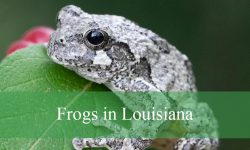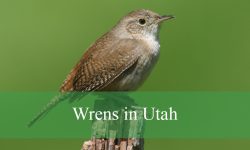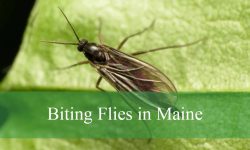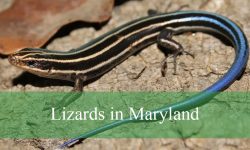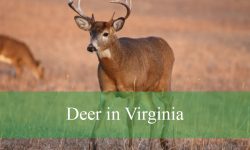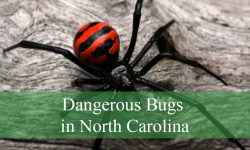Georgia is a paradise for birdwatchers, offering a rich variety of herons that grace its wetlands, rivers, and coastal marshes. Their elegance and hunting grace make each sighting unforgettable.
From the towering Great Blue Heron to the tiny Green Heron, every species brings unique colors, behaviors, and charm. Observing them requires patience, keen eyes, and a love for quiet moments in nature.
Exploring freshwater marshes or coastal tidal flats in Georgia reveals a world of wading birds in action. Each heron demonstrates skill, beauty, and the delicate balance of wetland life.
Types of Herons Found in Georgia
Great Blue Heron (Ardea herodias)
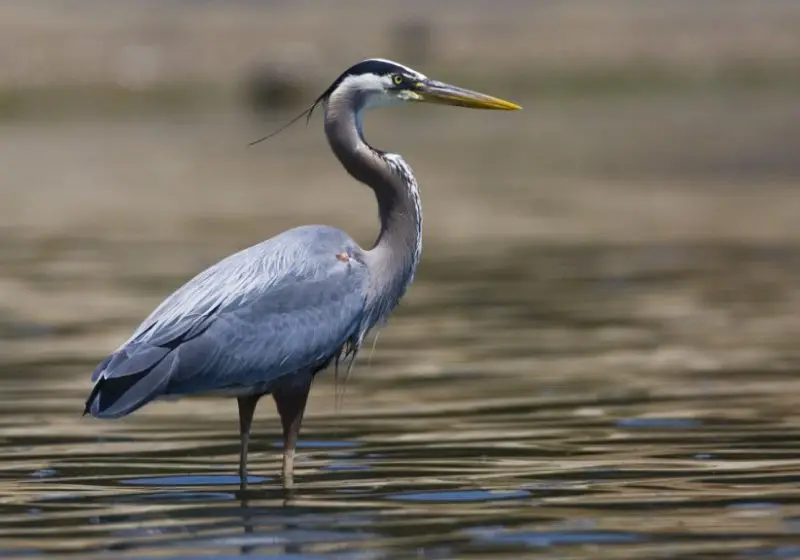
The Great Blue Heron is the largest heron in North America, standing up to 4.5 feet tall with a wingspan exceeding 6 feet. Its slate-gray plumage, long S-shaped neck, and strong, slender legs give it a commanding presence along rivers, lakes, marshes, and coastal shorelines. Its sharp, yellowish bill allows it to capture fish, amphibians, and occasionally small mammals.
These herons are solitary hunters, often standing motionless for long periods in shallow water, waiting for prey to come within striking distance. They strike with incredible speed and precision, swallowing fish whole. In addition to hunting in water, they occasionally forage in fields or lawns for insects and small rodents.
Great Blue Herons typically build large stick nests high in trees near water, sometimes forming loose colonies called rookeries. Nests can be reused year after year and often grow impressively large, measuring up to 3 feet in diameter. Both male and female contribute to nest construction and feeding the chicks.
During the breeding season, adults develop long plumes on their necks and backs, which are displayed in elaborate courtship rituals. These displays include bill clapping, bowing, and stretching the neck to signal readiness to mate, strengthening pair bonds for the season.
Despite their size, Great Blue Herons are graceful in flight, gliding silently with slow, steady wingbeats and retracting their necks into an S-shape. In Georgia, they can be found year-round in suitable wetlands and are highly adaptable to both freshwater and coastal habitats.
Great Egret (Ardea alba)
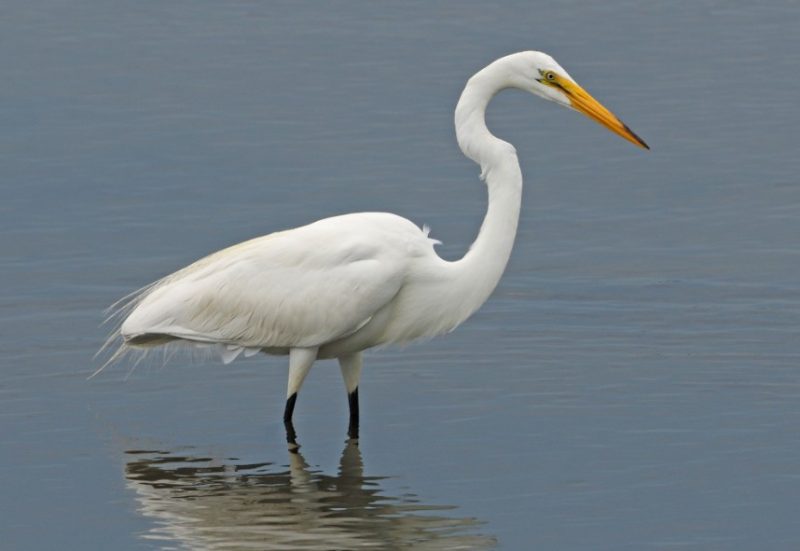
The Great Egret is a tall and elegant bird, standing nearly 4 feet high with a wingspan around 5 feet. Its pure white plumage, long yellow bill, and black legs make it one of the most recognizable wading birds in Georgia’s wetlands, ponds, rivers, and coastal marshes.
These egrets are patient hunters, wading slowly in shallow waters to capture fish, frogs, and small crustaceans. They often stand motionless for minutes, waiting for prey to come close, before striking with precision. Their slender, pointed bill is perfectly adapted for spearing aquatic animals.
Great Egrets build nests in colonies, frequently alongside other wading birds such as herons and ibises. Their large stick nests are usually located high in trees near water, and both parents participate in incubation and feeding of chicks. These colonies provide safety and increased breeding success.
During the breeding season, adults grow long, delicate plumes called aigrettes along the back and chest, which were highly prized in the plume trade of the 19th century. Today, these plumes are used for visual signaling in courtship displays, which include neck stretching, wing flicking, and aerial displays.
Great Egrets are highly adaptable, inhabiting freshwater marshes, swamps, rivers, and estuarine environments. In Georgia, they are more common during warmer months, but some populations remain year-round, providing a stunning sight for birdwatchers.
Snowy Egret (Egretta thula)
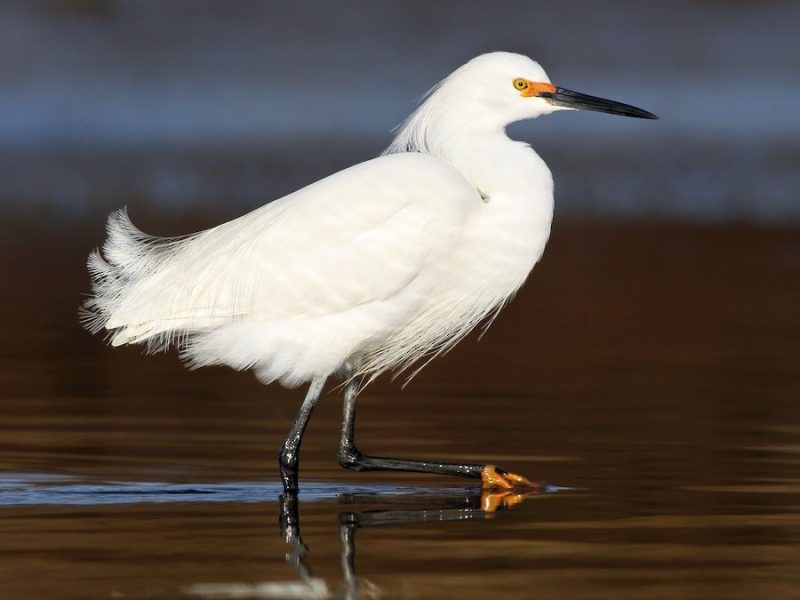
The Snowy Egret is a small, delicate heron, measuring about 24 inches tall with a wingspan near 3.5 feet. Its all-white plumage, slender black legs, and striking yellow feet make it one of the most visually appealing birds of Georgia’s wetlands. Its bright yellow feet are used to stir up prey in shallow water, a hunting technique known as “foot-stirring.”
Snowy Egrets actively hunt in tidal flats, marshes, and shallow ponds, feeding on fish, crustaceans, insects, and small amphibians. They are quick and agile, often moving rapidly through the water, darting and pouncing to capture prey. Their hunting style contrasts with the slow stalking typical of larger herons.
These egrets are colonial nesters, often nesting in trees or shrubs alongside other wading birds. Nests are small, made of sticks and lined with softer material. Both male and female Snowy Egrets participate in incubation and raising the chicks, which fledge after about a month.
During the breeding season, Snowy Egrets develop wispy, ornamental plumes on the head, neck, and back. Males use these plumes in courtship displays, spreading them to attract mates while performing elaborate dances and calls.
Snowy Egrets are widespread throughout Georgia’s coastal and inland wetlands. Their combination of elegant appearance and active hunting behavior makes them a favorite for photographers, birdwatchers, and nature enthusiasts seeking lively wetland wildlife.
Little Blue Heron (Egretta caerulea)
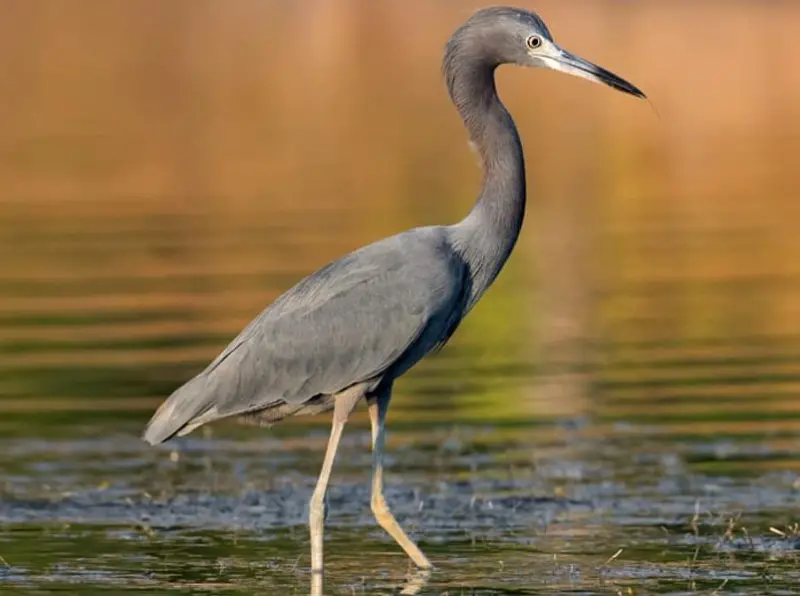
The Little Blue Heron is a medium-sized heron, with adults displaying deep slate-blue plumage, a slender black bill, and dark legs. Juveniles are entirely white, which sometimes causes confusion with other egret species. Adults grow to around 24 inches tall, with a wingspan up to 3.5 feet.
Little Blue Herons feed in freshwater and brackish habitats, using slow, deliberate stalking to hunt small fish, amphibians, crustaceans, and insects. They are solitary foragers, often moving through shallow water quietly to avoid startling prey.
These herons nest in small colonies, typically in shrubs or trees near water. Nests are made from sticks and are reused for several seasons. Both males and females share responsibilities in incubating eggs and feeding young, which usually fledge after 4–5 weeks.
The transition from juvenile white plumage to adult blue takes about a year, during which time young birds may be mistaken for Snowy Egrets. This juvenile stage also helps them avoid aggression from adults when feeding in colonies.
Little Blue Herons are found across Georgia in marshes, pond edges, swamps, and estuaries. Though less conspicuous than Great Blue Herons or Great Egrets, their striking blue coloration and graceful hunting make them a rewarding species for birdwatchers to observe.
Tricolored Heron (Egretta tricolor)
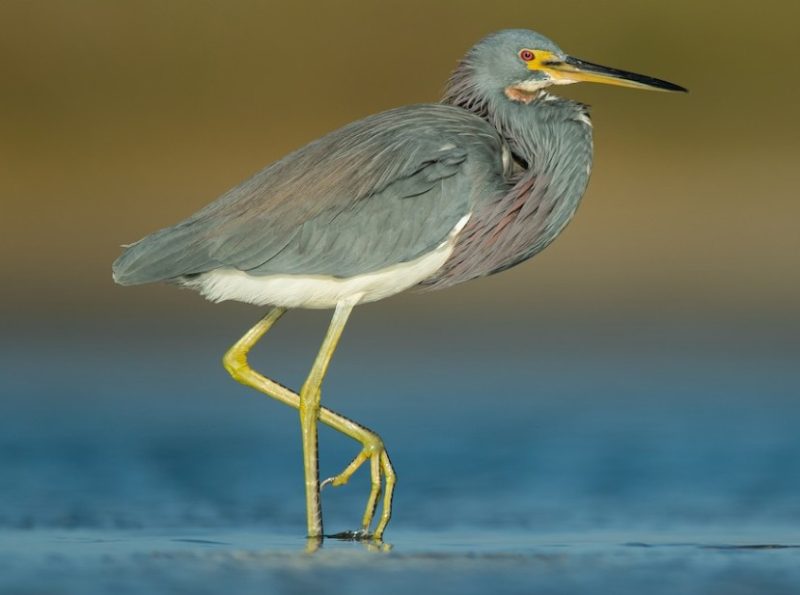
The Tricolored Heron is a medium-sized heron, easily recognized by its blue-gray body, white belly, and reddish-brown neck. Its long, pointed bill and thin legs make it a skillful hunter in shallow waters. Adults reach about 24 inches in height with a wingspan of 3.5 to 4 feet.
Tricolored Herons feed primarily on small fish, amphibians, and aquatic insects. Unlike some herons that hunt passively, Tricolored Herons use active hunting techniques, moving quickly, chasing prey, and using rapid stabbing motions to capture food.
These birds nest in colonies, often sharing trees or shrubs with other herons and egrets. Nests are constructed from sticks and lined with finer plant material. Both parents care for the eggs and chicks, which fledge in about a month.
During courtship, Tricolored Herons perform displays that highlight their colorful plumage. These include stretching the neck, flicking the wings, and calling to attract mates. The contrast between the blue-gray back and reddish neck is particularly striking during these rituals.
In Georgia, Tricolored Herons are most commonly found in coastal marshes, tidal flats, and estuaries. Their active hunting style and vivid coloration make them a favorite for wildlife observers, and they are often seen alongside Snowy and Great Egrets.
Green Heron (Butorides virescens)
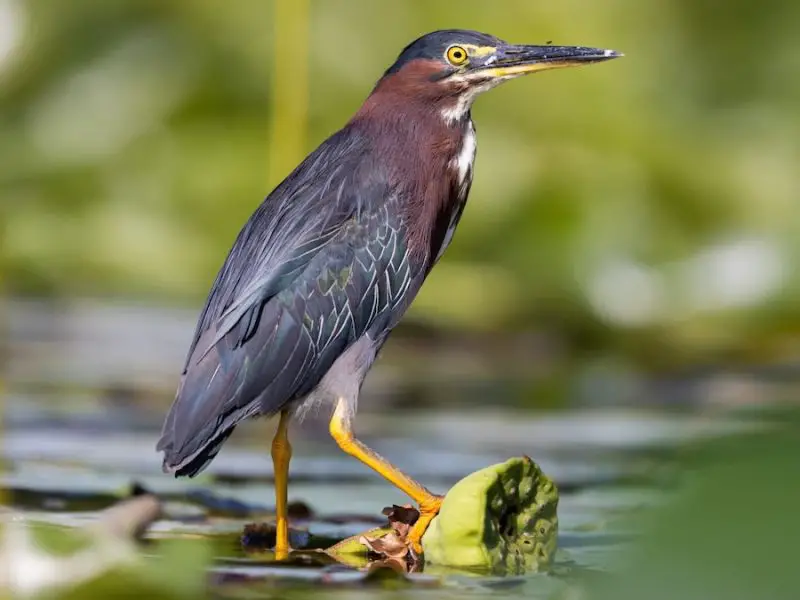
The Green Heron is a small, stocky heron, standing around 16–18 inches tall with a wingspan of about 25 inches. Its back is a dark greenish-black, the neck and chest are chestnut, and it has a sharp, dark bill. Despite its small size, it is highly skilled and patient in hunting.
Green Herons are often found along freshwater habitats such as ponds, marshes, streams, and the edges of swamps. They hunt quietly, stalking fish, insects, and amphibians, often using tools like floating leaves or insects to lure prey closer—a rare behavior among birds.
They usually nest in shrubs or low trees near water, often in small colonies. Their nests are made of sticks and are relatively compact. Both males and females participate in incubating the eggs and feeding the chicks, which fledge after about three weeks.
During breeding season, adults display vibrant colors on the head and neck, and males may perform bowing and wing-spreading displays to attract mates. Their quiet and secretive nature makes them less conspicuous than larger herons.
Green Herons are year-round residents in Georgia and adapt well to suburban waterways. Their clever hunting strategies and compact size make them fascinating to observe, especially in small ponds or streams.
Black-crowned Night-Heron (Nycticorax nycticorax)
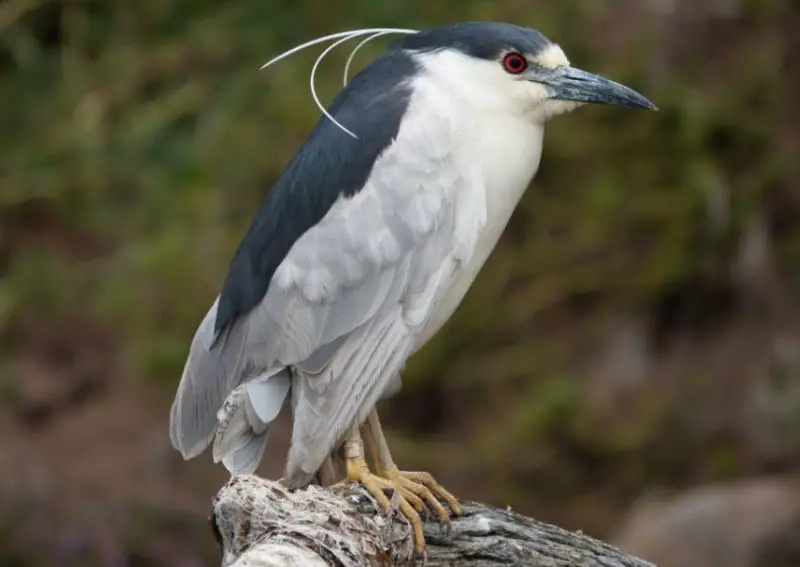
The Black-crowned Night-Heron is a medium, stocky heron, about 24 inches tall with a wingspan up to 4 feet. Its distinctive black crown and back contrast sharply with its gray body and white underparts, and it has bright red eyes that help it see at night.
Unlike many herons, this species is primarily nocturnal, hunting at dusk and during the night. Its diet includes fish, amphibians, crustaceans, and small mammals, which it captures with short, precise strikes in shallow water.
Black-crowned Night-Herons nest in colonies called rookeries, often alongside other heron species. Nests are made of sticks in trees or shrubs near water. Both parents share incubation and feeding duties, and chicks fledge after four to five weeks.
During courtship, adults perform bill clapping, neck stretching, and calling to attract mates. Their stocky appearance and quiet demeanor during the day make them easy to overlook despite their presence in local wetlands.
In Georgia, Black-crowned Night-Herons inhabit freshwater and coastal marshes, swamps, and river edges. Observers are more likely to see them leaving their roosts at dusk or early evening, when they become active hunters.
Yellow-crowned Night-Heron (Nyctanassa violacea)
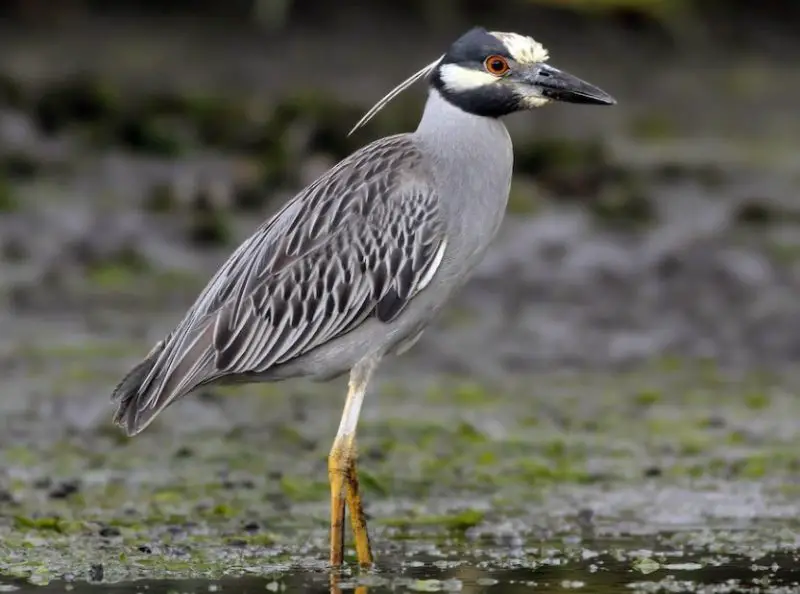
The Yellow-crowned Night-Heron is a medium-sized heron, slightly larger than the Black-crowned Night-Heron, with a gray body, black face, and pale yellow crown. Adults reach about 24–28 inches in height with a wingspan of 42–46 inches.
Primarily nocturnal, this heron feeds at night along marshes, tidal creeks, and coastal shorelines. Its diet is specialized, favoring crustaceans such as crabs and crayfish, but it also eats fish and insects when available.
Nesting occurs in colonies near water, often in trees or dense shrubs. Nests are made of sticks and are lined with softer materials. Both parents incubate eggs and feed chicks, which fledge after approximately four weeks.
During the breeding season, adults display long plumes on the back of the head and may engage in head-bobbing and calling displays. These visual and auditory signals strengthen pair bonds and attract mates.
Yellow-crowned Night-Herons are common in Georgia’s coastal regions and occasionally inland. Their specialized diet and nocturnal behavior make them unique among the herons, often seen foraging under the cover of darkness.
Reddish Egret (Egretta rufescens)
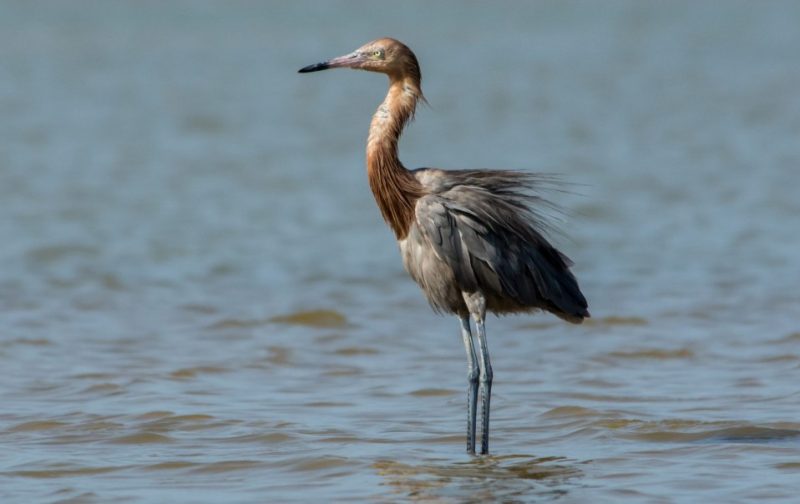
The Reddish Egret is a medium heron notable for its reddish head and neck, slate-gray body, and long, pointed bill. Adults measure around 26–30 inches in height, with a wingspan of 46–50 inches, giving them an elegant and slightly lanky appearance.
These herons are active, energetic hunters, often seen “dancing” across shallow waters to chase fish. They use rapid movements, spreading their wings and running in circles to herd prey, a behavior rarely seen in other heron species.
Reddish Egrets nest in colonies, usually in coastal mangroves or salt marshes. Their nests are built from sticks and lined with softer plant material. Both male and female care for the eggs and feed the chicks, which fledge after about a month.
During breeding season, the reddish plumage becomes more vibrant, and long head and neck feathers are displayed in courtship dances. These displays are striking and visually dramatic, making them stand out among other coastal birds.
In Georgia, Reddish Egrets are rare, typically found along coastal marshes and tidal flats. Their bold hunting style and vivid colors make them a prized sighting for birdwatchers along the coast.
Cattle Egret (Bubulcus ibis)
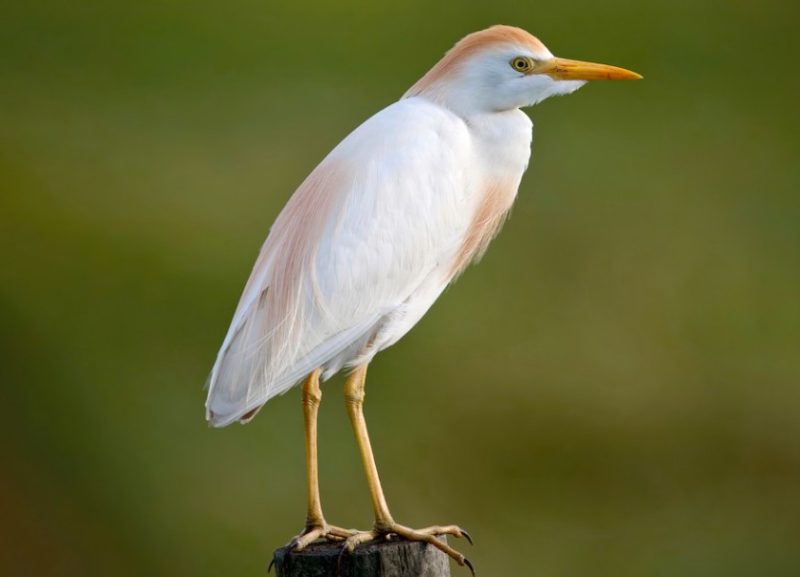
The Cattle Egret is a small, stocky heron with white plumage and a short yellowish bill. Adults measure around 22 inches tall with a wingspan of 36–40 inches. During breeding season, buff-colored plumes appear on the head, chest, and back, adding ornamental flair.
Unlike most herons, Cattle Egrets often feed in grasslands or pastures rather than aquatic habitats. They follow livestock such as cattle and horses, feeding on insects and small animals stirred up by grazing animals.
Cattle Egrets nest in colonies near water or trees, building stick nests in shrubs or low trees. Both parents share incubation and feeding responsibilities. Chicks fledge after roughly four weeks and often remain near the colony for some time.
During courtship, males display ornamental plumes and perform bowing and neck-stretching movements to attract mates. The combination of visual and auditory displays helps strengthen pair bonds in the breeding season.
Cattle Egrets are common throughout Georgia, especially in pastures, fields, and wetlands. Their association with livestock makes them easy to observe, and their social foraging behavior is a notable contrast to the solitary hunting of other herons.
Little Egret (Egretta garzetta)
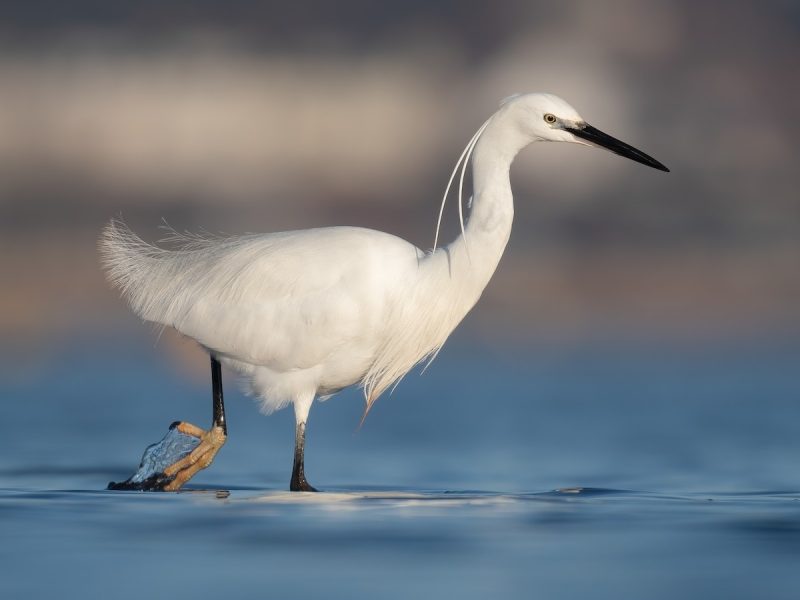
The Little Egret is a rare vagrant in Georgia, usually seen along coastal wetlands or estuaries. It is a small, all-white heron with black legs and yellow feet, standing around 24 inches tall with a wingspan near 40 inches.
This egret hunts in shallow waters, feeding on small fish, crustaceans, and insects. It often employs active hunting methods, using quick steps and sudden strikes to capture prey efficiently. Its yellow feet are especially useful for luring or startling prey in muddy water.
Little Egrets nest in colonies, sometimes alongside other herons and egrets. Nests are constructed from sticks in shrubs or low trees near water. Both parents participate in incubation and chick rearing, with fledging occurring in about a month.
During the breeding season, adults display long plumes on the head, neck, and back. Males use these plumes in courtship rituals, performing bowing, wing flicking, and aerial displays to attract mates.
Though rare in Georgia, Little Egrets are more common in coastal areas further south. Their delicate appearance and elegant hunting behavior make them highly prized among birdwatchers when sightings occur.
Lava Heron / Black Heron (Egretta spp.)
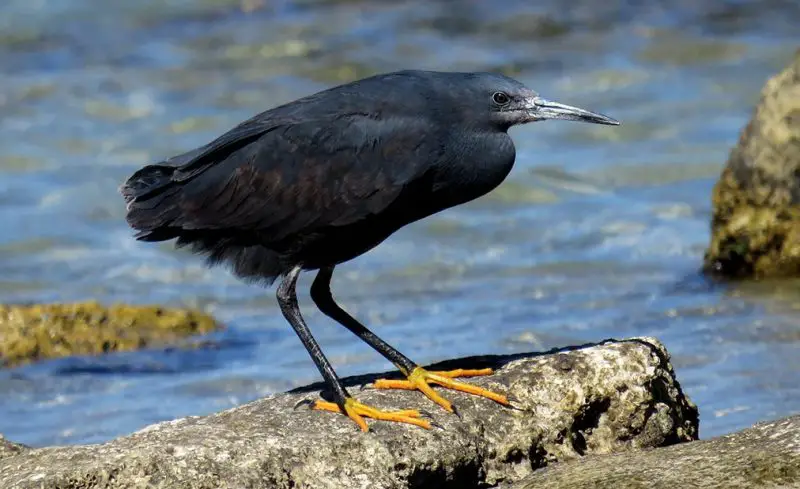
The so-called Lava Heron, or Black Heron, is an extremely rare visitor to Georgia, usually associated with coastal sightings. It has nearly all-black plumage, giving it a dramatic and shadowy appearance. Adults are medium-sized, standing around 24–28 inches tall with a slender build.
These herons are active hunters, often using wings to create shade over water and corral fish—a behavior known as “canopy feeding.” Their diet consists of small fish, crustaceans, and aquatic invertebrates.
Nesting habits are similar to other egrets, often in colonies near water. Nests are constructed of sticks and lined with plant material. Both parents share incubation and feeding responsibilities.
During courtship, visual displays are important due to the uniform dark plumage. Males may stretch their necks, spread wings, and perform calling displays to attract mates.
In Georgia, sightings are extremely rare and usually limited to coastal habitats. Their unique feeding behavior and striking dark coloration make them an extraordinary find for birdwatchers and photographers.
FAQs about Herons in Georgia
What types of herons can be found in Georgia?
Herons in Georgia include Great Blue Herons, Great Egrets, Snowy Egrets, Little Blue Herons, Tricolored Herons, Green Herons, Black-crowned Night-Herons, Yellow-crowned Night-Herons, Reddish Egrets, Cattle Egrets, Little Egrets, and the rare Lava or Black Heron.
Where do Great Blue Herons typically live in Georgia?
Great Blue Herons are commonly found in freshwater and coastal wetlands, such as rivers, lakes, marshes, and estuaries. They prefer shallow water areas where they can hunt fish, amphibians, and small mammals.
How can you identify a Snowy Egret?
Snowy Egrets are small white herons with black legs and bright yellow feet. They are known for their active hunting behavior, often running and stirring water to catch fish and other small prey.
What is the difference between juvenile and adult Little Blue Herons?
Juvenile Little Blue Herons are completely white, which can make them look similar to young egrets. Adults gradually develop slate-blue plumage with a dark bill and legs, making them easier to identify.
Are Black-crowned Night-Herons nocturnal?
Yes, Black-crowned Night-Herons are primarily active at dusk and during the night. They hunt for fish, amphibians, crustaceans, and small mammals in shallow waters under low light conditions.
Do Cattle Egrets only live near water?
No, Cattle Egrets are often seen in grasslands and pastures. They commonly follow livestock, feeding on insects and small animals disturbed by grazing cattle and horses.
When is the best time to see Tricolored Herons in Georgia?
Tricolored Herons are most commonly observed during the summer months in coastal marshes, tidal flats, and estuaries. They are active hunters, moving quickly through shallow water to catch fish and crustaceans.
What makes Reddish Egrets unique?
Reddish Egrets are known for their “dancing” hunting style, actively chasing fish across shallow waters. Their reddish head and neck with a slate-gray body make them visually striking compared to other herons.
Are Yellow-crowned Night-Herons common in Georgia?
Yellow-crowned Night-Herons are moderately common, especially in coastal areas. They are nocturnal and primarily feed on crustaceans like crabs and crayfish, but they also eat fish and insects.
Can you see Little Egrets in Georgia often?
Little Egrets are very rare in Georgia and usually appear as vagrants along coastal wetlands. Sightings are prized by birdwatchers due to their all-white plumage and yellow feet.
What is the Lava or Black Heron?
The Lava or Black Heron is an extremely rare visitor in Georgia. It has nearly all-black plumage and uses a hunting technique called “canopy feeding,” where it spreads its wings to shade water and corral fish.

